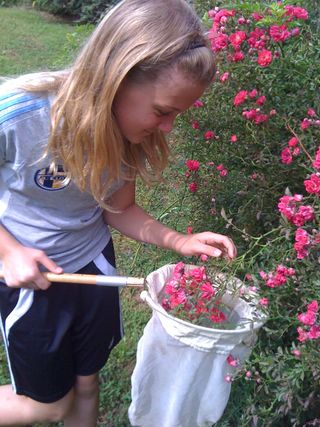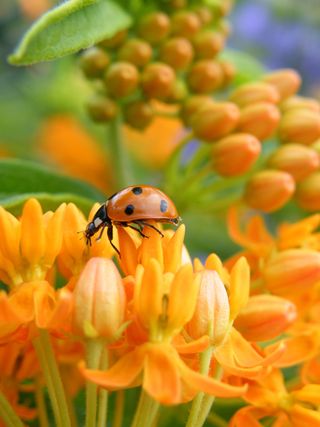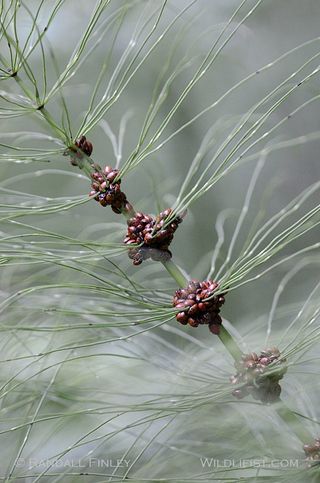Everyday Citizens Can Help Solve the Riddle of the Disappearing Ladybugs

This Behind the Scenes article was provided to LiveScience in partnership with the National Science Foundation.
Who doesn’t like ladybugs?
The elegant little crimson beetles are a child’s introduction to the world of insects as they make their way gently along a tiny finger before flying off in the spirit of the old nursery rhyme, “Ladybug, ladybug. Fly away home.”
But in the last two decades, the populations of various North American ladybug species have been changing in significant ways. Some species have been declining — some even dwindling to a precious few individuals. At the same time, the populations of other ladybug species have been increasing and expanding their ranges; some species have even colonized entirely new regions.
Interactions with exotic species, global climate change and shifting land use patterns have been cited as potential causes for the decline of some ladybug species. But scientists need a clear picture of how and why ladybug populations are changing, why these changes are occurring so rapidly, what the impacts of these changes will be on ladybug diversity or on their ecological and economic roles. These roles include controlling the populations of insects that feed on plants and crops.

To help explain the changes, the nationally recognized Lost Ladybug Project, which is partly funded by the National Science Foundation — is running a census of ladybugs. This census involves monitoring ladybug numbers across the U.S. with the help of a cadre of concerned citizen scientists — thousands of volunteers who make and record observations in their own areas and then submit them to the project.
The project is among a growing number of citizen science projects. In citizen science, volunteers provide data for scientists to use in their research, potentially for publication.
Sign up for the Live Science daily newsletter now
Get the world’s most fascinating discoveries delivered straight to your inbox.
“We need pictures of every ladybug, even the same species over and over again,” says John Losey, associate professor of entomology at Cornell University and founder and director of the project. “Because if we don’t have evidence of how common the common species are, we won’t know how rare the rare ones are.”
It would be impossible to count every single ladybug in every single meadow. However, Losey and his colleagues can extrapolate from the citizen-scientist data to estimate how many ladybugs are out there, where they are concentrated and the status of various species.
Losey explains that, in general, the most stable or sustainable species are those that are very common across a broad geographic and habitat range. “The worst-case scenario is that we stop finding individuals of a species at all,” says Losey. If volunteers look for ladybugs and don’t find any, that is valuable information. “Zeroes are useful data, too,” he says.
“A species for which small numbers are found, but only in a restricted habitat or geographic range is obviously not extinct, but may still be vulnerable,” says Losey. “For species where limited sightings exist, finding additional individuals, especially when the spatial or geographic range is extended, definitely gives us hope that they may be less vulnerable then we feared.

Paradigm shifter
“We have plenty of situations where single observations have changed our knowledge of where rare species still exist,” Losey said. In 2009, he says, a 6-year-old child in eastern Oregon found the ladybug “poster child” — the Coccinella novemnotata, or nine-spotted ladybug. (It is named for the number of black dots on its orange shell.)
“We started out knowing they could be found in high and dry places, such as parts of Colorado and South Dakota — and even the panhandle of Nebraska. When this young citizen scientist started sending in C. novemnotata photos, we were very excited because of how far this extended its known range,” he says. “But in terms of habitat, it still made sense to us.”
The project asks volunteers to look for ladybugs around backyards and neighborhoods, carefully recording the time and place of each sighting and, if possible, snapping a photo that entomologists can use to identify the species.
Losey acknowledges that feisty ladybugs aren’t always particularly cooperative photography subjects. But when a ladybug is dropped into a jar and then put into the freezer for five or fewer minutes, it usually will slow down long enough to be captured in a close-up photo. (Important note: more than 5 minutes of freezer time can kill ladybugs.)
Growing corps
Volunteers contributing to the Lost Ladybug Project include individuals of all ages as well as groups organized by scouting clubs, nature centers, schools, camps, botanical and community gardens and other organizations. Note to parents and others seeking fun and educational summer activities for children: Consider looking for lost ladybugs with them.
The number of volunteers has grown rapidly, from about 1,000 in 2008 to more than 4,000. This is due, in part, to coverage by many national media outlets — including The New York Times, USA Today and Scientific American, to name just a few. (The project’s Web site features a hyperlinked list of articles.)

Urgent need
The effort to recruit volunteers has taken on new urgency due to an apparent alarming decline in the number of ladybugs found in areas that were crawling with them relatively recently. For example, nine-spotted ladybugs used to be so abundant in the eastern U.S. that the species had been named the official state insect of New York. But they have virtually disappeared over the past 40 years. They were even thought to be locally extinct before a scientist documented one hanging around an organic farm on Long Island. Losey said, “This was not only a major extension of its known geographic range, but it changed our whole paradigm, because it was definitely not a high dry western location.”
It has been theorized that the decline of the nine-spotted ladybug was caused by climate change or perhaps the arrival of competing ladybug species. Some scientists suggested the nine-spotted had nearly bred itself out of existence by mating with these competitors.

Ladybug Ecology
Farmers welcome ladybugs regardless of how many spots they have, because the little predators have a hearty appetite for aphids and other pests. Losey says that, according to the project’s research, natural enemies of insects contribute about $4.5 billion dollars to the U.S. agricultural economy; ladybugs are integral members of this group.
“Their main job is that they eat other insects. If we didn’t have ladybugs, we would need to use much higher levels of pesticides,” Losey says. “So they are not only saving us money and saving crops, but they are also contributing to human health by reducing the level of pesticides we need.”
Sign Up!
The Lost Ladybug Web site features guidance on finding, identifying and photographing ladybugs, instructions on uploading photos, the latest ladybug news, educational resources, including teaching curriculums, as well as activities for kids (including a ladybug song).
During the last four years, more than 17,000 ladybug photos/reports have been contributed to the project, including specimens from all 50 states, Mexico and Canada. But Losey says, “We know we need a lot more data to tell this story.”
Citizen Science: The Big Picture
The Lost Ladybug Project is one of more than 600 citizen science groups that annually engage over 100,000 volunteers in scientific research on a wide range of topics, including how molecules in cells work, biodiversity, weather, climate change, astronomical phenomena and many other topics.
To learn more about citizen science groups, read an overview article on citizen science and citizen science resources, an article about a citizen science group that is helping to document climate change, an article about prison inmates who are helping scientists study endangered plants, an article about a group that is helping to measure and analyze earthquakes around the world, and an article about citizen science programs devoted to bird conservation and biology.
Further reading: 'Lost' Ladybugs Found Again in South Dakota
Editor's Note: The researchers depicted in Behind the Scenes articles have been supported by the National Science Foundation, the federal agency charged with funding basic research and education across all fields of science and engineering. Any opinions, findings, and conclusions or recommendations expressed in this material are those of the author and do not necessarily reflect the views of the National Science Foundation. See the Behind the Scenes Archive.
